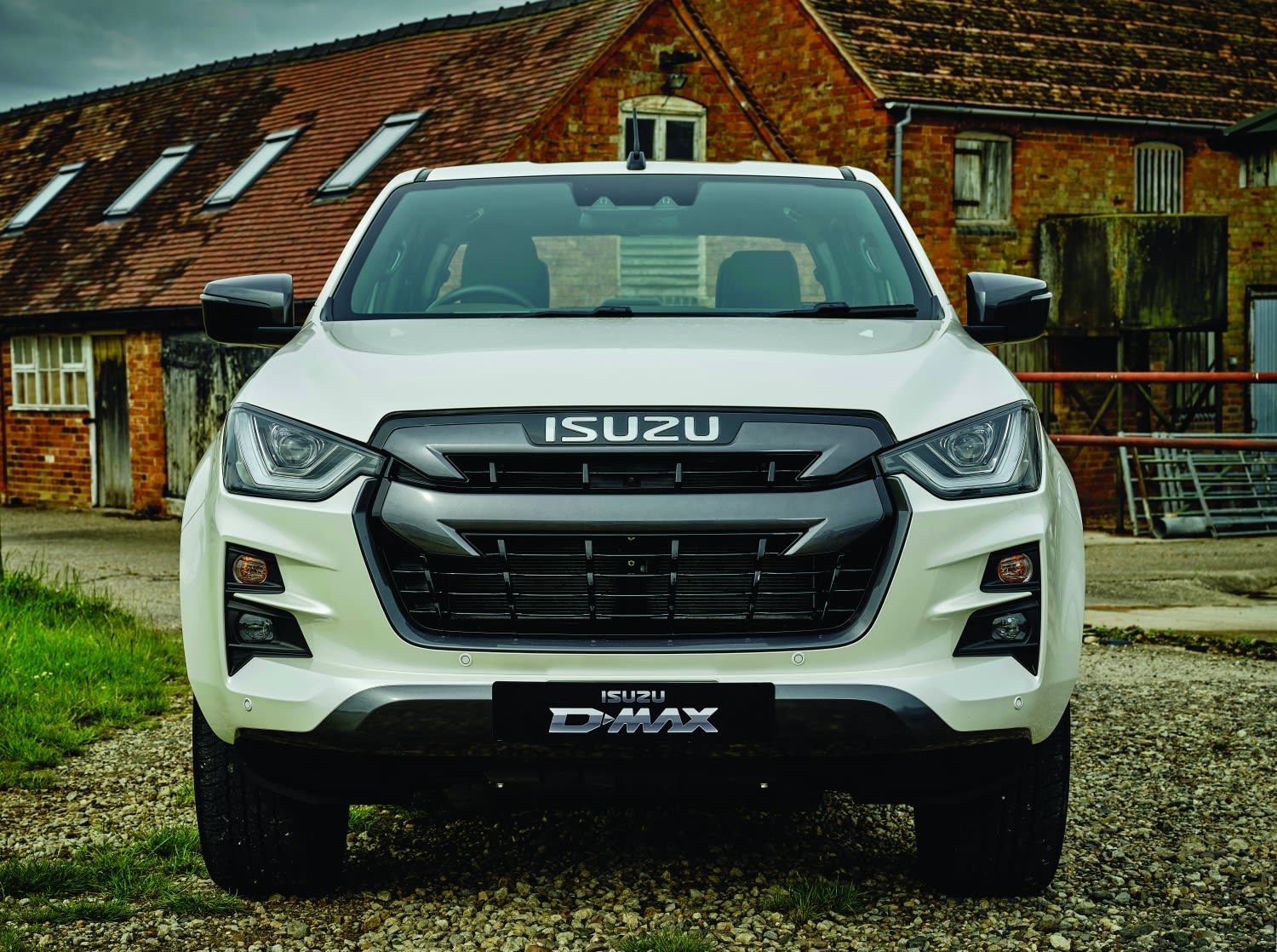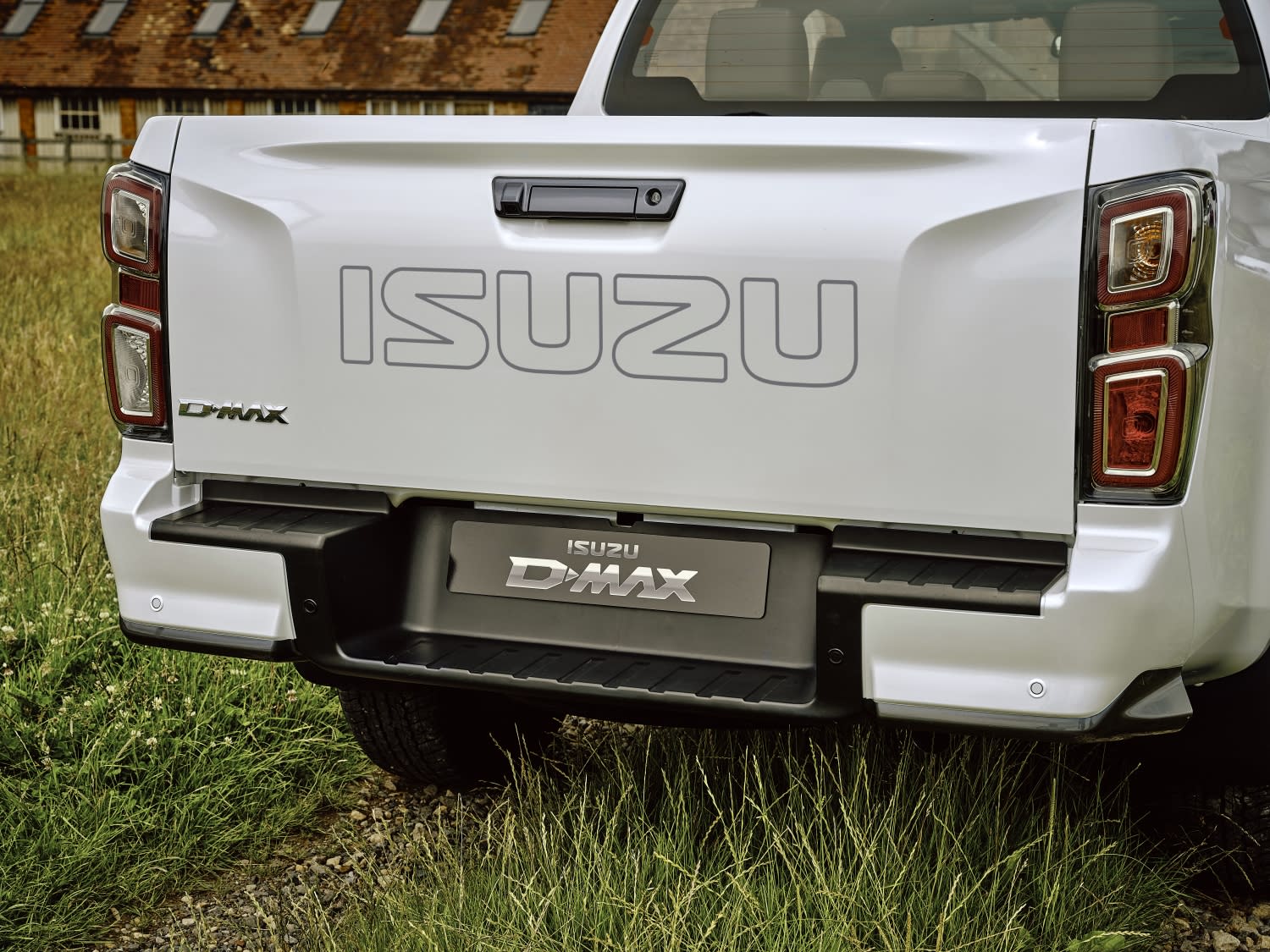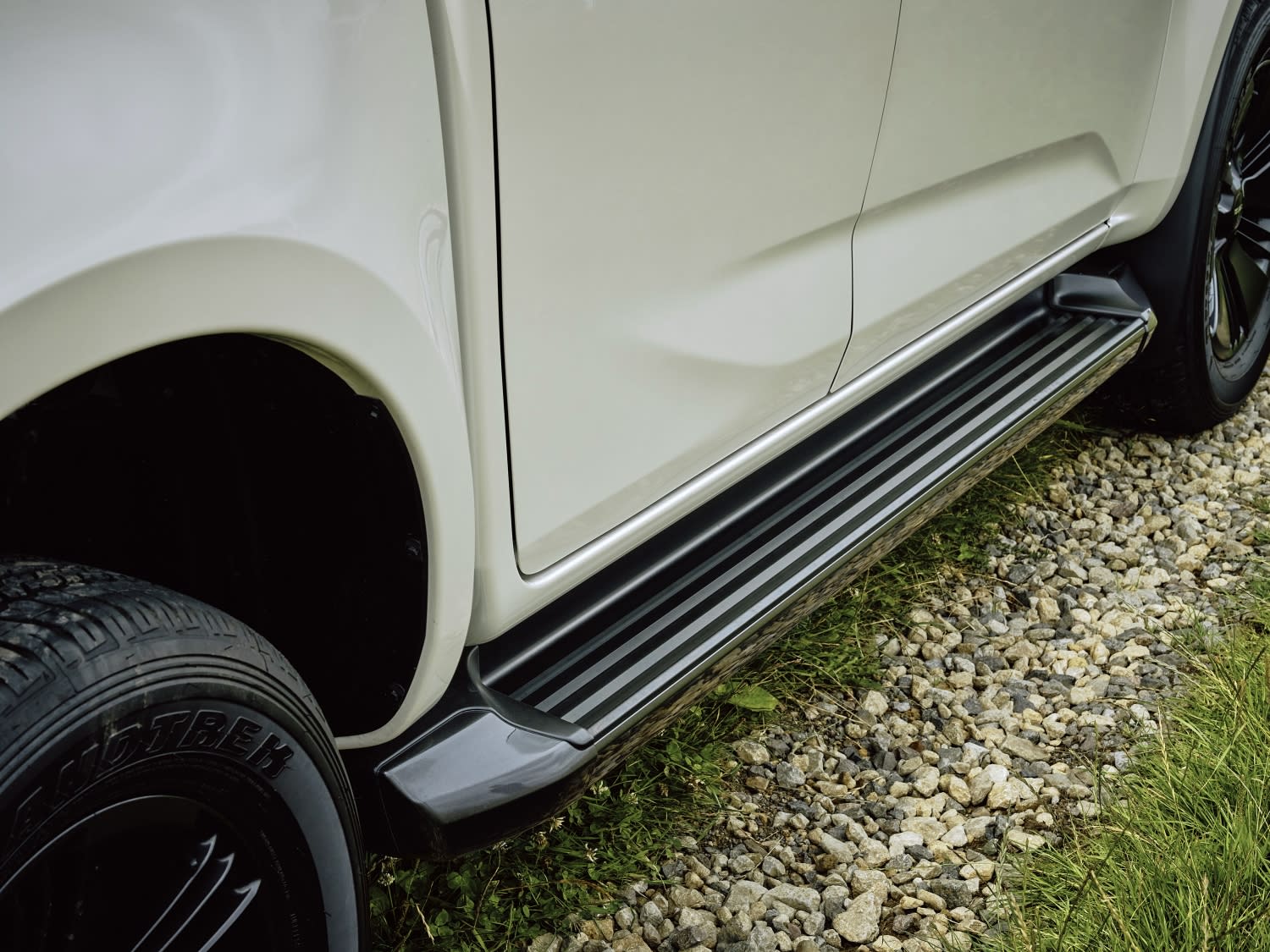
Isuzu D-Max Review

Introduction
The pickup truck has, in recent years, moved from a pure workhorse function to something that’s a genuine alternative to a regular car. Helped by preferable company car tax rates for commercial vehicles, manufacturers have been scrambling to make their trucks more car-like, which for consumers means a range of vehicles that will haul almost anything during the week but also carry the family around at the weekend.
Isuzu has been a best-selling pickup for years in the UK, and this latest version doesn’t just improve its practicality, it also adds new safety and comfort features to appeal to those lifestyle customers as well as businesses.
Review Sections
Select's rating score* - 3.6 / 5
At a Glance
Isuzu doesn’t make cars; it only makes trucks and commercial vehicles, and it’s very good at them. The D-Max has been a best-selling truck in the UK alongside the Toyota Hilux and Ford Ranger for a long time, and this third-generation model, introduced at the start of 2021, looks set to continue that. It’s improved the functionality of the previous model, but on top of that it offers a range of body styles and some very car-like features to widen its appeal. On top of all that, an impressive set of standard safety features and a great reputation for reliability make it a very attractive vehicle.
Key Features
The Isuzu D-Max is, first and foremost, a working truck, and that hasn’t changed for this latest model. The company knows that its capability and reliability are what won its existing fans and so it’s not about to change those strengths. That means that across the range there's more space inside for passengers, more space in the back for hauling things and very impressive four-wheel drive off-road capability.

But in addition, there are new and clever features to make life easier day-to-day, improved styling and improved interior quality, as well as plenty of new comfort and entertainment features. Oh, and some class-leading safety too.
You can choose between single cab, extended cab or double cab models to strike difference balances between passenger capability and load bed space. Most of the higher-end models will be double cab.
Performance & Drive
It might sound obvious, but you have to remember when driving it is that the Isuzu D-Max is a truck, not a car. That’s important if you’re coming to it from the world of SUVs, as the Isuzu is a machine built to carry heavy loads, and for durability, so it’s not as refined or as sophisticated as a car, no matter how many features have been added into it.
But for a truck, it drives well in comparison to others. The ride can be a bit bouncy, especially when there’s no load in the back, but you’re unlikely to complain about it. Through the corners it’s wallowy compared to an SUV, but against other trucks it performs very well, helped by its comparatively low weight. The steering is light enough for easy manoeuvring but weighty enough for it to feel confident at faster speeds.
There’s only one engine choice, and it’s a 1.9-litre diesel with 162bhp. Compared to some of the powerhouses found in other pickups, that might not sound much, but it’s plenty in the D-Max, again helped by a weight that’s considerably lower than rivals. One other advantage is that, as it tips the scales at less than 2,040kg, the D-Max isn’t subject to the lower speed limits imposed on other, heavier rivals. Trucks that weigh more than that, including the Toyota Hilux and some models of Ford Ranger, are legally obliged to follow limits that are 10mph lower on single and dual carriageways, but the D-Max can cruise at the same speed as cars.
The engine is rather gruff but it pulls very well. You can choose between a six-speed manual gear-box or a six-speed automatic, which isn’t the quickest of devices when it comes to shifting, but does the job it needs to. The grunt of the engine means it can tow well too, with all but the entry-level model having a 3.5-tonne braked towing capacity, while the payload in the back can be up to 1,205kg.
All models except the entry-level model have four-wheel drive, which gives them very impressive off-road ability. Higher-end models have a locking rear differential to help tackle really tricky terrain, and there’s hill descent control for traversing particularly steep declines. If you need to go through water then you’ll be grateful for the D-Max’s 800mm wading depth.
Running costs
Monthly leasing costs had yet to be decided at the time of writing, but if it reflects purchase prices then you can expect the D-Max to be very similar to Ford’s Ranger and a good chunk less than the Toyota Hilux. Stronger resale values on the new D-Max could mean it’s cheaper than the outgoing model, but we’ll have to wait and see.

When it comes to fuel, expect to pay a bit more than you would for a large SUV (pickups aren’t the most aerodynamic of things), but with official combined MPG figures of between 30.7 and 33.6, the D-Max is competitive against the competition and better than the more powerful versions. You can expect mid-to-high 20s MPG in the real world.
Insurance could be relatively pricey however, as all D-Maxes sit in the top 50D insurance group.
Emissions
Specific emissions figures aren’t particularly relevant for the D-Max, as because it’s a pickup it’s subject to a flat rate for benefit-in-kind company car tax. That means bills of either £700 or £1,400 a year, depending on whether you pay 20% or 40% tax. The engine is Euro 6D compliant.
Interior
The D-Max’s interior is vastly improved compared to the previous model, and it’s far more car-like. There’s a lot more soft-touch plastic around, although you’ll still see a lot of harder plastics when compared to most SUVs. It’s not quite as plush as the interior of the SsangYong Musso, but it’s really not bad. The front seats have nice big side bolsters, the seat adjusts in six different ways and the steering column adjusts for both reach and rake, which is something that not all other trucks can offer. This makes it much easier to find a great seating position.

The Utility line of D-Maxes is a proper working truck, with vinyl on the floor to make it easier to clean than carpet. But the level of luxury rises with the other lines, aimed at those that want to use the truck at home as well as work.
Technology
The Utility line of trucks is relatively spartan but still features creature comforts like air-conditioning, DAB radio and Bluetooth, as well as a CD player. The mid-spec DL20 model gives you an improved speaker set up, while the DL40 has a 7.0-inch touchscreen infotainment system. It’s not the most sophisticated interface, but it does have wireless Apple CarPlay and Android, which means you can plug your smartphone in and use entertainment and navigation apps through the screen. On the top-spec V-Cross model, the screen increases in size to 9.0 inches.
Practicality & Rear Space
Practicality is the D-Max’s middle name, although to what extent depends on what model you choose. If you want maximum load space in the back, you’ll need the single cab, although that’s only available in entry-level Utility trim. Still, that gives you a load bed that measures 2,315mm by 1,530mm, and seats two up front.
If you may need occasional rear passenger space, the extended cab model sacrifices a bit of load space to squeeze in jump seats. They’re very rudimentary, and suitable only for very short journeys, but if you use the D-Max for work and might need to carry a couple of colleagues across town then it’s worth looking at. The load bed on extended cab models drops to 1,805mm in length.

For maximum passenger space, the double cab models give you a proper three-person rear bench, so if you need your D-Max to do family as well as work, duty (or you have lots of colleagues) then this is the one to go for. The top-spec V-Cross and DL40 models are only available in double cab form. This drops the load bed to 1,495mm long, but it means there’s plenty of room inside.
There are also lots of storage spaces inside, with four cupholders up front, two smallish gloveboxes and big door bins, as well as a cubby hole under the centre armrest. Double and extended cab models have underseat storage, and in the double cab the rear seats can flip up or fold down to give you extra options for carrying things.
Safety
The D-Max excels when it comes to safety. It’s the first truck to be awarded the maximum five stars in tests by independent safety organisation Euro NCAP, and every model comes loaded with cutting-edge systems more usually found in passenger cars.
These systems include automatic emergency braking, which will intervene if you don’t react to an impending accident, as well as lane departure warning and prevention technology. All models have front, side, curtain and driver’s knee airbags, and double cab models have another airbag in the centre too. There are two Isofix child seat mounting points on the outer rear seats of double cab models, but none in the back of the extended cab. Double cab models also have a blind-spot monitoring system.
Options
There’s plenty of choice when it comes to how you want your D-Max. Broadly, the range is split into three. The Utility range is very much aimed at work use, with all three body styles available. The single cab model is also available with rear-wheel drive only, but all other models are four-wheel drive. The Utility models ride on steel wheels and feature all the above safety kit, automatic headlights and wipers and manual air conditioning.

Rival Cars
Historically, the D-Max has had plenty of pickup rivals, although the market has tightened considerably in recent years. The Volkswagen Amarok, Mitsubishi L200, Nissan Navara and Mercedes-Benz X-Class will not be available to buy for much longer in the UK.
However, the D-Max’s traditional rivals remain, in the form of the Toyota Hilux and Ford Ranger. Both of these sell in bigger numbers than the D-Max, so if you want to stand out a bit then the Isuzu could have the upper hand. The Hilux is expensive too, and both the Ford and Toyota can fall foul of the speed limit issue previously mentioned. That said, they have the option of bigger engines if you need them.
There’s also SsangYong’s Musso, which is very nice inside although suffers from a pretty bad ride quality.
Verdict & Next Steps
In a market that’s offering less choice to consumers, thanks to the exit of some big-name brands, the Isuzu D-Max provides a welcome and very competent challenge to the Toyota Hilux and Ford Ranger.
It has a lot of things going for it, with great handling compared to those rivals and a weight that lets it go a bit faster on the roads. On top of that, it’s got excellent off-road capability, class-leading safety features and a wide range of body style and trim choices to suit different needs. If you’re coming into it from an SUV then you might raise your eyebrows at some of the levels of refinement, but that’ll be the case with any truck. It also lacks the big engine, performance options that rivals can boast.
But overall, the D-Max should be right at the top of your new truck shopping list.
Where to next?
View latest Isuzu D-Max leasing deals- guide price from £249.83 per month inc VAT**
Looking for a great leasing deal? Check out our incredible range of Special Offers
New pick-up? Read our latest reviews and find the right model for you
Want to know more about leasing? Take a look at our comprehensive Leasing Guides
Interested in everything motoring? Why not catch up on all the latest Van Leasing News.
*Score based on Select’s unique meta score analysis, taking into account the UK’s top five leading independent car website reviews of the Isuzu D-Max
**Correct as of 21/04/22. Based on 9 months initial payment, 5,000 miles over a 48 month lease. Initial payment equivalent to 9 monthly payments or £2,248.47 Ts and Cs apply. Credit is subject to status.


















